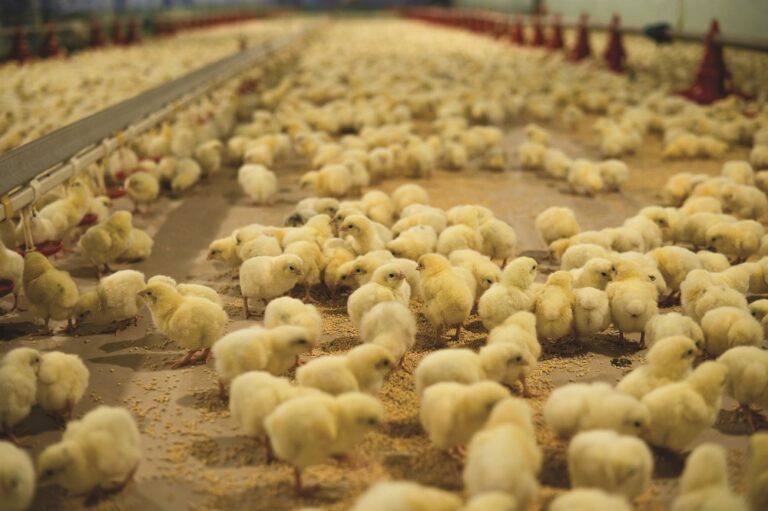Breeding chick numbers are down, indicating the recovery from the COVID-19 lockdown is likely to be slow, even if fast food chains are starting to reopen.
Once again, there are queues forming outside drive-thru McDonald’s and KFC. But the reopening of the economy won’t quickly translate into a return to pre-COVID levels of poultry production. And falling prices are putting an enormous strain on the poultry meat industry.
Placements of female breeding chicks for the broiler industry declined 4% in April, compared to 2019, according to Defra data, which also shows day old broiler chick placements were down 1% year-on-year in April, while layer chick placements were down 6.2% in April.
The fall in breeding chicks on farm will mean poultry meat production will be constrained in the medium term, with a lag likely even as demand increases from foodservice outlets.
As of 29 May, KFC had reopened 700 of its UK restaurants with new perspex screens and social distancing rules. As of 3 June, McDonald’s had opened 497 restaurants for drive-thru orders.
Chick placement
Tom Wornham is a broiler grower and chair of the NFU’s poultry board. He says the closure of pubs and restaurants resulted in a net reduction is demand for poultry meat, even as major supermarkets made record sales. “The sector has reacted by reducing the number of chicks placed on farm by approximately 15% or 3 million less birds per week.
“Farmers, such as myself have increased the period of time between chick placement from a standard 12 days to 22 days in my case, to accommodate the reduction in number of birds the market can sell.”
It is clear even though the economy is starting to reopen, it will be some time before numbers return to pre-COVID levels.
Charles Bourns, Gloucestershire broiler grower and chair of the egg and poultry working group at Copa-Cogeca, the European farming union, says across Europe, the numbers are equally as stark.
“Lockdown measures put a stop to all out of home consumption,” he says. “This represents 20-40% of production, depending on the member state. And in the case of some species, almost 100%. ‘Small species’, such as duck, pigeon, quail, guinea fowl or goose cannot be sold easily or at all through retail due to very distinct differences in their supply chains.”
Twenty million less chicks per week
If there is a bottleneck at the level of breeders or processors, the effects are felt immediately and for a long time throughout the entire supply chain. As a result, many farms are only partially stocked or completely empty today.
“They will have little to no income until situation goes back to normal, so the situation is dire. Since the beginning of the crisis, I estimate that one billion chickens have been lost,” says Bourns. “If we include ducks and quail, approximately twenty million chicks are not being placed on farms each week.”
Bourns believes many poultry farms in the UK and the EU will need government help to survive. Prices for poultry have fallen as demand has collapsed in the foodservice sector.
He points to data showing staggering 12% drop in price has occurred over the last seven weeks putting even greater pressure on European producers. “Should this dynamic continue, many farmers will be forced out of business. This will have a knock-on effect that results in the loss of thousands of jobs in rural areas at a moment when all forecasts indicate that we are heading into a long recession.
“In the short term, and to avoid full collapse of the sector and ensure food security, our farmers are asking for support to keep their farms, investments and jobs, so that they can be ready to restart their operations when the demand comes back,” he says. “We can’t afford to wait years for this aid to reach us through complex and confusing bureaucratic channels, we need it now. The situation on the ground requires urgent action to be taken.
“At the same time, in the specific case of poultry, private storage aid would be extremely useful for the duration that HoReCa is closed. However, in a situation where prices are falling due to oversupply, and while a lot of farms are empty and the actors of the supply chain are not working at full capacity, it is obvious that imports from third countries should be tightly managed according to changes in consumption habits. Authorities must make sure that these imports are in line with international law and follow the letter of the treaties.”
Turning the tap back on
Matt Donald is a broiler breeder from north Yorkshire, taking Aviagen breeding stock from PD Hook.
He says during the height of the lockdown, hatcheries had cancelled orders for broiler chicks “some of those were already in the setters”.
“It’s very hard to turn the tap on and off,” he says.
During this period, his breeder flock was culled several weeks early, in order to not over supply the chick market and keep some balance through the hatchery. However, this has now changed, and the current flock will stay the full 60 weeks on farm.
He says if demand starts to pick up as the wholesale market and foodservice industry reopens, there is some room for manoeuvre, and birds that were due to be culled at 60 weeks could be kept on, and the turnaround period of five to six weeks could be shortened in order to bring a new flock in sooner.
Case Study
Tom Wornham grows broilers on his farm in Cambridgeshire for IHP, which supplies halal poultry into the retail and wholesale markets.
“When this kicked off, the chickens we were growing were for the wholesale sector; they were 3.4 kg sized birds destined for the restaurant trade. Immediately we were asked to grow a smaller bird suitable for retail, so our programme was brought forward.
“Luckily IHP was able to divert poultry from wholesale into retail. They also have contracts with independent butchers and butchers are doing quite well, but there was just a massive shift in volume from one sector to the other.
“The number of birds being consumed reduced in the UK, from around 21.5 million to 17 million birds a week, which is why you see the reduction in your chick placement of broiler breeders, so as opposed to me working on a normal 14 day turn around, that turnaround period was extended. It’s probably going to take three years to get that breeding stock up to same capacity as it was before this crisis started.
There are only a small number of businesses that provide the breeding stock. And then to get them back in the system you have to start by clearing sheds, getting the breeding flock ready and then up to productive level, that’s a 20-22 week cycle. So, to get those birds to lay their first eggs its 21 weeks from now.
“In the retail sector nothing’s really changed but for my sector at the moment we had an extended period of when my birds were placed at the end of April, and this time I’ve got 30 days off at the moment. That’s how the company is trying to juggle supply and demand.”



